Vox: Jennings
After Tom Jennings left Vox, he
formed Jennings Electronic Industries, and produced a few organs under his own name. Except for
the "normal" colored keyboards, they look remarkably
similar to the Vox models, and appear to share many common traits. I
believe the model numbers indicate the year in which they were made or sold.
J.68/J.70
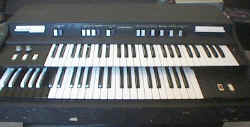 |
I saw this J.68
listed on the VEMIA Auction.
The buyer contacted me and was gracious enough to supply the pictures
and some of the information you see here. Since
then, I read about it in Peter Forrest's "A-Z
of Analogue Synthesisers". He lists it as a J.70, but it's
identical to the J.68 pictured here. The nameplate on this one,
however, clearly identifies it as a J.68.
(J.68 pictures courtesy of Nick
Steele)
|
Controls:
Tabs(left side): Mellow, Pulse On, Pulse Slow/Fast, Tone I,
Tone II, Tone III
Drawbars:
Bass: Two drawbars, for volume and tone
Lower Manual: 16', 8', 4', IV, Tone (two, probably "~"
and "M")
Upper Manual: 16', 8', 5-1/3', 4', 2-2/3', 2', 1-3/5', 1',
Tone (two, probably "~" and "M")
Tabs(right side): Mellow, Perc, Perc 8', Perc 4', Perc 2-2/3',
Perc 2'
Left
of upper Keyboard:
Knobs: Pedal Sustain, Tremolo Speed.
Rocker switches: Bass 16'/8', Tremolo, Vibrato
Back
panel: Slide switch to select Pedal or Manual bass.
Additional info from Peter Forrest's "A-Z": Bass
voice can be either 8' or 16', not both at once. The "Pulse"
tabs control an external rotating speaker cabinet, called the "P.O.
I 'Pulsation Unit'". I think this is probably simlar
to the Vox Gyrotone (see the Riviera
page for a description
of the Gyrotone)
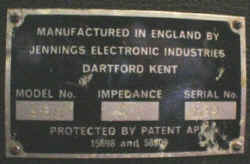
And here's a couple of pages from an old Jennings flyer,
depicting the J.70, the "P.O.I. Pulsation Unit", and some other cool
stuff:
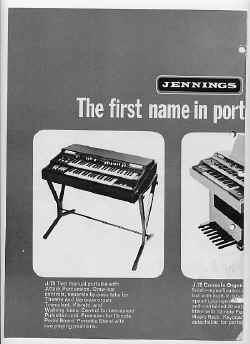

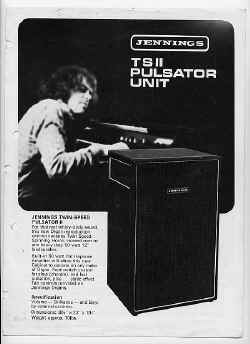
(Flyers courtesy of Henry B.)
J.71
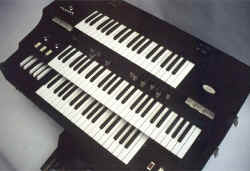 |
This must be one of the
only three-keyboard combo organs out there. It's identical to the J.70,
with the addition of the top keyboard and associated voices. |
The Flyer says "..identical specification of the J.70, plus a third
manual with 3 octaves providing 16' - 8' - and 2' pitch with separate control of
tonal effects, i.e. Vibra-harp, Piano, String, Percussion, Sustain, etc. (Repeat
Percussion and in-built Wah-Wah as optional extras)".
Here's what Peter Forrest ("A-Z of
Analogue Synthesisers") has to say, regarding the extra manual:
"This manual has
a rather confusing control system, using six push-buttons and a knob,
and obviously shares some of the tone generation of the 'ordinary'
upper manual - i.e. the top manual on a J.70. If one or the
other of the Tone drawbars or the Tone control tabs for the second
manual aren't being used, 'the Upper Manual will not speak'."
"The principal
selling point is the release available on this top manual -
'Finger-Off Sustain', as Jennings called it. One button
switches in an 8' tone which will hang on after the key is released,
and another changes the tone of this release. Other buttons
switch in a 2' tone and percussion, and a 16' tone and it's timber. The amount of 16' tone mixed in is controlled by a knob."
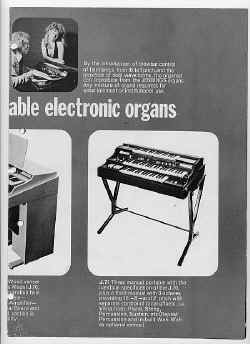
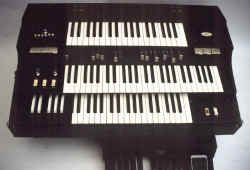
Thanks to Joe D. for the following pictures of another specimen:

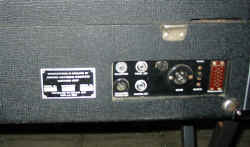
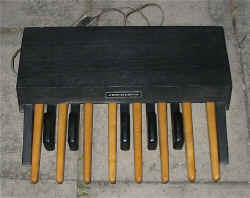
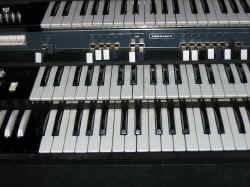
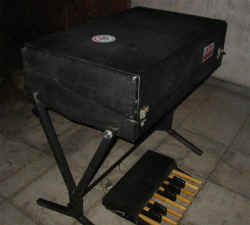
J.72
A J.70 in a console cabinet. Sounds like it had some sort
of rotating speaker built in. You can see it to the side of the flyers shown above. I
pasted the two together below:

Detachable keyboard section? Looks like somebody was hanging out at Vox
Sound while the Riviera's were being made - or perhaps it was the other way
round?













